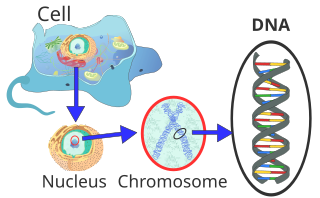Transcription is process by which the information in a strand of DNA is copied into a new molecule of messenger RNA (mRNA). mRNA is comparable to a copy from a reference book because it carries the same information as DNA but is not used for long-term storage and can freely exit the nucleus. Although the mRNA contains the same information, it is not an identical copy of the DNA segment, because its sequence is complementary to the DNA template. Transcription is carried out by an enzyme called RNA polymerase and a number of accessory proteins called transcription factors. Transcription factors can bind to specific DNA sequences called enhancer and promoter sequences in order to recruit RNA polymerase to an appropriate transcription site. Together, the transcription factors and RNA polymerase form a complex called the transcription initiation complex. This complex initiates transcription, and the RNA polymerase begins mRNA synthesis by matching complementary bases to the original DNA strand. The mRNA molecule is elongated and, once the strand is completely synthesized, transcription is terminated. The newly formed mRNA copies of the gene then serve as blueprints for protein synthesis during the process of translation. The copying is along the same lines as already explained, (A for T, G for C, C for G) except that a different base called U (uracil) replaces T (thymine).
On Friday, before our class start, my classmates Sayyi, Shafiqah, Aqilah and I was presented about a microbe based on topics provided to them. I was presented about the Chlorella vulgaris. Later on, Dr Suriana taught us about translation and Gene Regulation. Translation process by which a protein is synthesized from the information contained in a molecule of messenger RNA (mRNA). During translation, an mRNA sequence is read using the genetic code, which is a set of rules that defines how an mRNA sequence is to be translated into the 20-letter code of amino acids, which are the building blocks of proteins. Ribosome is a factory of protein synthesis. Three steps of Translation which is chain initiation is assembly of ribosome, mRNA start codon, and initiator tRNA anticodon. Chain Elongation is ribosome moves codon-by-codon and codon-anticodon pairing results in the
formation of specific amino acids chain, polypeptide. Chain Termination is when the ribosome reaches stop codon, polypeptide is released and translation complex disassembles.
Gene regulation is mechanisms to increase or reduce production of RNA or protein because energy conservation, environmental adaptation and enzyme activity regulation. Regulation can occur during different stages of gene expression which is transcriptional regulation, translational regulation and post-transcriptional or posttranslational regulation. Regulation of Gene Expression which is gene expression refers to the combined process of transcription and translation of genetic information to a functional protein, not all genes are expressed at any one time, nor are they always expressed at the
same level. Gene expression is tightly regulated, or controlled, so that the cell only makes the gene
products that it needs for efficient growth under its current environmental conditions. An operon is regulatory protein binding region and downstream gene(s). Regulatory proteins called repressors or activators act as off and on switches for transcription, respectively. Negative regulation involves repressor proteins that respond to cell conditions so to actively repress (prevent) RNA Polymerase from beginning transcription of the gene (or operon) by binding onto the DNA at the operator site. Positive regulation of transcription also can occur. Here, environmental conditions in the cell causes an activator protein to bind to the promoter site for a gene (or operon), which enables RNA Polymerase to begin transcription. Operon is a group of genes that consists of Promoter is region where RNA polymerase initiates transcription, Operator is region adjacent to structural genes
that controls their transcription and Structural genes is genes with related functions.




